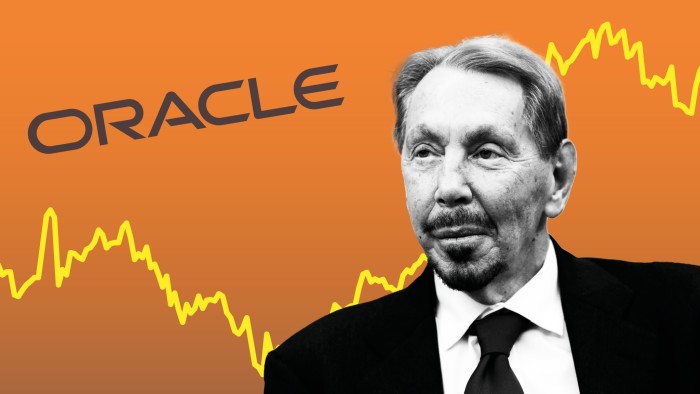Unlock the Editor’s Digest for free
Roula Khalaf, Editor of the FT, selects her favourite stories in this weekly newsletter.
Oracle shares surged 31 per cent to a record in pre-market trading on Wednesday, propelling co-founder Larry Ellison’s wealth close to that of the world’s richest person Elon Musk.
The jump came after the software company reaped the reward from the boom in artificial intelligence in results on Tuesday evening.
Oracle, which was late to pivot its business into cloud computing services, has benefited from a groundswell in demand for data centre infrastructure from AI start-ups and other major technology groups.
Chief executive Safra Catz hailed an “astonishing quarter” that included Oracle signing “four multibillion-dollar contracts with three different customers” in the three months to the end of August.
Those deals helped push Oracle’s bookings, which will feed through into future revenue, to $455bn in the three months to the end of August, surpassing analysts’ expectations and up from $138bn in the previous quarter.
Wall Street had been primed for a rise in bookings following the disclosure of a new $30bn-a-year contract Oracle signed in July, but had not anticipated such a steep rise in its book of future business. Earlier this year, Oracle signed a deal to partner with OpenAI and SoftBank on the $500bn Stargate project.
Before Wednesday’s surge, Oracle’s share price had already gained 40 per cent this year. If it maintains the pre-market move, Oracle’s market value is on track to rise from $678bn to $890bn.
Ellison owns 41 per cent of the shares and his overall wealth would be close to that of Tesla boss Musk, according to Bloomberg’s Billionaires Index.
On a call with investors on Thursday, Catz said Oracle had signed “significant cloud contracts with a who’s who of AI, including OpenAI, xAI, Meta, Nvidia, AMD and many others”.
Revenue from its infrastructure business would jump from $18bn this year to $144bn in five years’ time, she predicted. The forecast was nearly 60 per cent higher than the $91bn Wall Street expected.
By comparison, revenue at Amazon Web Services, the biggest cloud company, topped $107bn in its last full year.
The rapid growth has left Wall Street analysts questioning how Oracle will be able to add computing capacity fast enough to handle the new demand, at a time when most cloud companies have complained of chip shortages.
Rival cloud computing companies Amazon, Microsoft and Alphabet, along with Meta, are on course to spend more than $350bn between them this year on data centres and other AI infrastructure and more than $400bn in 2026.
Oracle lifted its capital spending forecast for its fiscal year to the end of next May by $10bn, to $35bn. Catz claimed the company was able to generate higher revenues with less capital spending than rivals because it does not invest in buildings and uses its computing equipment more efficiently. “I don’t want to call it asset-light . . . but it’s asset pretty light.”
Oracle has burst on to the scene as a significant player in the cloud market thanks to the heavy computing demands of training new AI models for a handful of customers.
But Ellison said the surge in future demand reflected a shortage of computing to run AI models after they had been trained, known as inferencing.
“People are running out of inferencing capacity,” he said on the call with analysts. “The inferencing market is much larger than the training market.”
For the latest quarter Oracle reported a 12 per cent gain in revenue, to $14.9bn, slightly below the $15bn Wall Street had been expecting. Adjusted net income rose 8 per cent to $4.3bn, higher than analysts’ expectations.
In July, it emerged OpenAI had agreed to lease 4.5 gigawatts of computing power from Oracle in a deal worth about $30bn a year. The move will entail Oracle developing multiple data centres across the US to satisfy the start-up’s computer-processing demands, having already reached a deal to supply a 1.2GW site in Abilene, Texas.
Read the full article here
